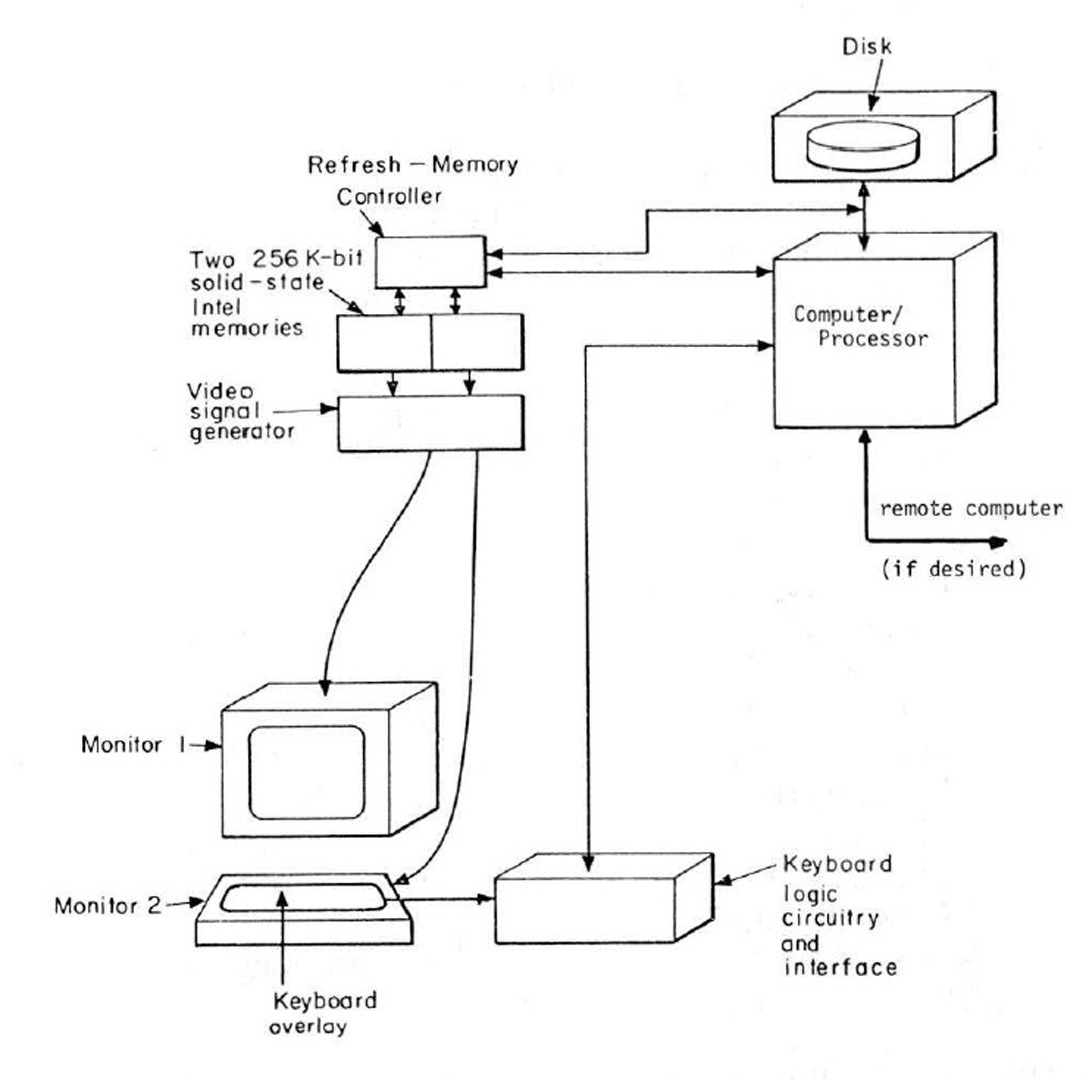“A computer-terminal, hardware/software system with enhanced user input capabilities: the enhanced-input terminal system (EITS)” by Kaplow and Molnar
Conference:
Type(s):
Title:
- A computer-terminal, hardware/software system with enhanced user input capabilities: the enhanced-input terminal system (EITS)
Presenter(s)/Author(s):
Abstract:
The Enhanced-Input Terminal project is directed at providing major new degrees of freedom for touch-type computer input, especially for on-line use of interactive computer systems. The terminal comprises an integrated of hardware and software. While various choices are available for the actual input and output devices, the present prototype utilizes video display for both devices and a “cross-wire”, touch-sensitive input panel. The EITS allows an “author” to define an essentially infinite set of symbols, and an infinite variety of “keyboard” formats. Chord inputs (i.e., simultaneous, multiple-“key” combinations) are also supported. Symbols can be defined in terms of dot matrices, generalized graphics, symbol strings, and functional operations. In spite of the complete generality afforded, the integrated system develops a standard-type of binary-bit-coded input stream, in which the individual symbols are uniquely and canonically represented, and which is amenable to all of the usual “text-file” operations, such as character manipulation, editing, transmission and re-display.
References:
1. D. O. Pettijohn, Use of the TICS System to Write a Computer Tutorial on the Wave Equation, S. M. Thesis, MIT, Department of Metallurgy and Materials Science (1972).]]Google Scholar
2. Roy Kaplow, S. H. Desch, F. C. Smith, Jr., D. O. Pettijohn and M. H. Rodman, Illustrations of Conversational, Inquiry, Problem-Solving, and Questionnaire Type Interactions within the TICS System, Proceedings of the Seventh Annual Princeton Conference on Information Sciences and Systems (March 22-23, 1973).]]Google Scholar
3. Roy Kaplow, D. S. Schneider, F. C. Smith, Jr., and W. R. Stensrud, TICS: The Author Language and Instruction Manual, Massachusetts Institute of Technology (1971); Computer Assistance for Writing Interactive Programs: TICS, Atlanta, Proceedings of the ACM Meeting, Georgia (August 1973).]] Google ScholarDigital Library
4. Mobyuki Goto, A Translator Program for Displaying a Computer Stored Set of Special Characters, Report ESL-R-429, MIT (1970).]]Google Scholar
5. Ibid, page 59, Figure 16.]]Google Scholar
6. A. D. Falkoff, K. E. Iverson, APL/360: User’s Manual, IBM Corporation (1968); K. E. Iverson, A Programming Language, Wiley (1962).]] Google ScholarDigital Library
7. Computer Display Terminal Model 4013 Data Sheet, Tektronix Inc., Beaverton, Oregon.]]Google Scholar
8. A few approaches to keyboards for numerical analysis systems are reviewed, for example, in: A. Ruyle, J. Brackett, and Roy Kaplow, The Status of Systems for On-Line Mathematical Assistance, Proceedings ACM 22nd National Meeting, 151-167 (1967); also, see: M. Klerer and J. May, Two-Dimensional Programming, Proceedings of the Fall Joint Computer Conference, 27, 63-75, Spartan Books, Washington, D. C. (1965).]]Google Scholar
9. F. J. Reintjes, Private Communication.]]Google Scholar
10. G. J. Culler and B. D. Fried, The TRW Two-Station On-Line Scientific Computer General Description, Computer Augmentation of Human Reasoning, Spartan Books, Washington, D.C. (1965).]]Google Scholar
11. New Concept in Man-Machine Interface Devices, Developments Section, Computer Design, 7, 32 (1968).]]Google Scholar
12. K. Knowlton, Virtual Pushbuttons as a Means of Person-Machine Interaction, Proceedings Computer Graphics, Pattern Recognition and Data Structure Conference, Beverly Hills, California (1975).]]Google Scholar
13. An early example of such hardware was the elaborate “Kludge” facility of the MIT Electronics Systems Laboratory; see: J. E. Ward, “Display Systems Research,” Project MAC Report: Progress to July 1974, MIT (1965).]]Google Scholar
14. See, for example, J. L. Little, ASCII Code Applications to Alphanumeric Display Terminals, Proceedings of the SID, 13/3, Third Quarter, 154 (1972).]]Google Scholar
15. T. H. Maugh II, in Research News, Science, p. 273 (October 19, 1973).]]Google Scholar
16. R. V. Baron and Roy Kaplow, User’s Guide for Crystrum I, MIT Department of Metallurgy and Materials Science (1973).]]Google Scholar
17. For a different discussion of these and related issues, see: D. G. Alden, R. W. Daniels, and A. F. Kanarick, Keyboard Designs and Operation: A Review of the Major Issues, Human Factors, 14, 275 (1972).]]Google Scholar
18. For a description of this computer, see: Processor Handbook, PDP 11/40, Digital Equipment Corporation, Maynard, Mass. (1972).]]Google Scholar
19. T. F. Knight, Artificial Intelligence Project, MIT, Private Communications.]]Google Scholar
20. T. Cheek, J. Ward, D. Thornhill, Operation and Programming Manual for the ARD-1 Experimental Dataphone-Driven Remote Storage-Tube Display, Project MAC Memorandum M-336, (1966); Storage Display Unit-Model 611 Data Sheet, Tektronix, Inc., Beaverton, Oregon.]]Google Scholar
21. W. E. Johnson and L. J. Schmersal, A Quarter-Million-Element AC Plasma Display with Memory, Technical Bulletin DU-130, Owens-Illinois (1971); Digivue Model 512-60 Data Sheet, Owens-Illinois, Perrysburg, Ohio.]]Google Scholar





